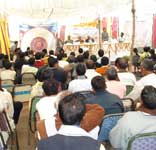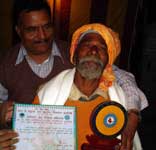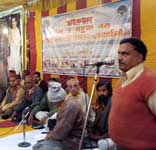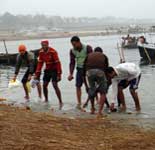- +91 9335 157 268
- shuklavn4@gmail.com
GANGA ACTION PLAN
The Ganga Action Plan was launched in 1985. This was to improve the water quality of river Ganga to the bathing standards, using a multi-pronged strategy. 1t was to be financed with Central assistance as 100 per cent grant-in-aid. This Action Plan envisaged interception and diversion of waste water reaching the Ganga and installation of Sewage Treatment Plants for treatment of this waste water. It also included other pollution control activities such as solid waste management, installation of electric crematoria, river front development and provision of low cost sanitation facilities in 25 Class I cities located along the river Ganga thereby improving the water quality of river Ganga to bathing quality. The plan also laid great emphasis on public awareness and participation to keep the Ganga clean. Overall the programme has been received well.
An apex body, named as the Central Ganga Authority was set up under the chairmanship of the Prime Minister to oversee the implementation of this Action Plan and coordinate the efforts of the various agencies involved at the Central and State levels. A Steering Committee under the chairmanship of Secretary, Ministry of Environment & Forests was constituted to consider the approval of schemes, annual allocation of funds and review of progress of implementation of scheme. A Monitoring Committee was also constituted to monitor progress of implementation of schemes. Ganga Project Directorate was set up as a part of the Ministry of Environment & Forests to service the Steering Committee, the Monitoring Committee and the Central Ganga Authority and to appraise and sanction schemes and to coordinate the implementation of Ganga Action Plan.
Ganga Action Plan Phase I (GAP-I)
The Ganga Action Plan Phase I (GAP-I) was started in 1985 to improve the water quality of River Ganga to acceptable standards by preventing the pollution load reaching the river. The GAP-I envisaged interception, diversion and treatment of 882 MLD out of 1340 MLD of wastewater estimated at that time, generated in 25 class-I towns in 3 States of Uttar Pradesh, Bihar and West Bengal (presently 1 in Uttaranchal, 5 in Uttar Pradesh, 4 in Bihar and 15 in West Bengal).
The main focus of the Plan, where a major part of public investment was made, was on tackling pollution from municipal sewage, accounting for about 75% of the river pollution.The approved cost for GAP-I was Rs.462.04 crores. Out of this, Rs.451.70 crore were released by the Government of India to the implementing agencies. Under GAP-I, 261 schemes were sanctioned for completion of which 259 schemes were completed. Two schemes of sewage treatment plants in Bihar could not be completed because of litigation problems. GAP-I for completion by March 1990, but extended it progressively upto 31 March 2000 when this phase was declared closed.
Ganga Action Plan Phase-II
Since GAP-I did not cover the pollution load of Ganga fully; the Ganga Action Plan Phase II (GAP-II) was launched in stages between 1993 and 1996. The total project cost of GAP Phase-II is Rs. 1498.86 crore The phase-II of the Ganga Action Plan was started in the year 1993. Under this phase, main tributaries of river Ganga, namely Yamuna and Gomti.
Rs in croreYear |
GAP-I |
GAP-II |
||||
|---|---|---|---|---|---|---|
Central Release |
Expenditure |
Release |
Expenditure |
|||
Centre |
State |
Total |
|
|||
Total |
436.9 |
432.68 |
383.03 |
167.95 |
550.98 |
469.03 |
Total for the GAP-I & II |
987.88 |
901.71 |
||||
Reason behind failure of Ganga Action Plan
The Audit in their review covering the period from the year 1993-2000 involving Rs.655.23 crores of the total releases, had stated that the Ganga Action Plan has met only 39 per cent of its primary target of sewage treatment,
The Government released a total of Rs 987.88 crore on the Plan since its inception; the states have reported expenditure of Rs 901.71 crore till March 2000. There were heavy shortfalls in the achievement of targets of creation of assets and facilities under the plan. Even those “achievements” were poor indicators of the extent of success of the plan, as most of them did not function either fully or partially for a variety of reasons.
The States reported expenditure of Rs 587.63 crore out of Government funds of Rs 655.23 crore released to the implementing agencies. Audit test check in the States found many instances of financial mismanagement
GAP started in 1985 with a completion date of 1990 has postponed its deadlines from 1990 to March, 2000 then to 2001 and recently to 2008. This clearly shows the inefficiency of governance, planning, lack of foresight on the implementation.
MAJOR GAP BETWEEN GAP AND LOCAL PEOPLE-
The people at large were either ignorant of or totally alienated from the objectives of GAP thereby creating a gulf between public and the schemes and projects. This ignorance also prevented them from playing an active role in assisting regulatory authorities in the implementation of schemes.
NATIONAL RIVER GANGA BAIN AUTHORITY
After spending crores of rupees and experiencing the failure of various action plans formulated to clean up the Ganges consistently for several years, the government has finally woken up to the futility of these exercises and as a path breaking initiative, the Prime Minister declaring the River Ganga as a National River date 4 November 2008 and also set up a National Ganga River Basin Authority as an empowered planning, implementing and monitoring authority for the Ganga River under the Environment (Protection) Act, 1986. There are Rs. 1400 crore has sanctioned to carry out the project.








